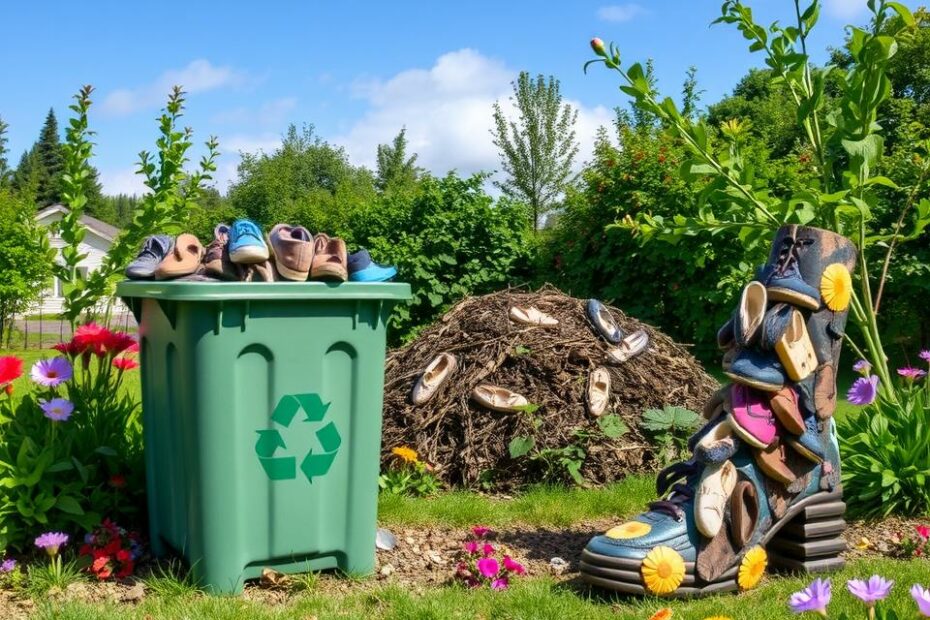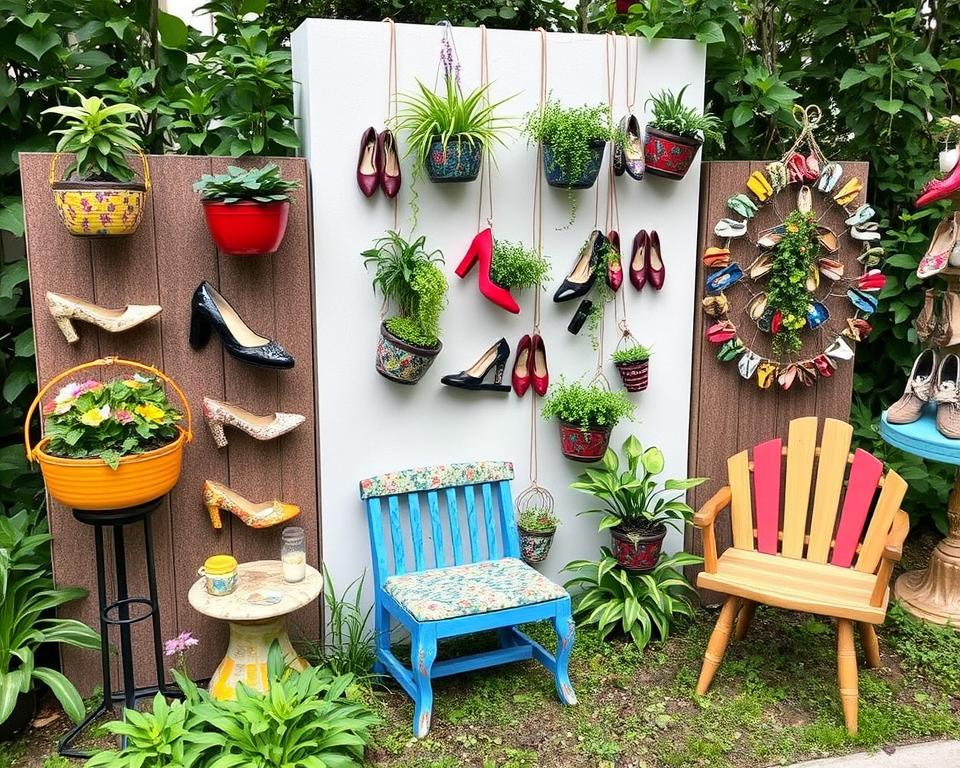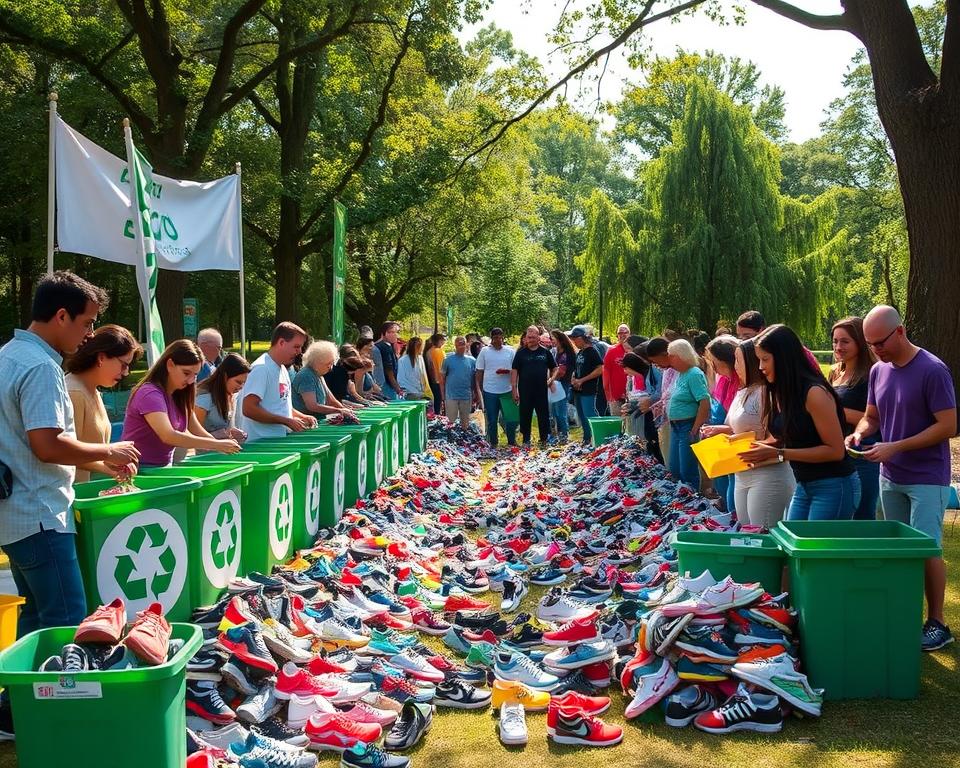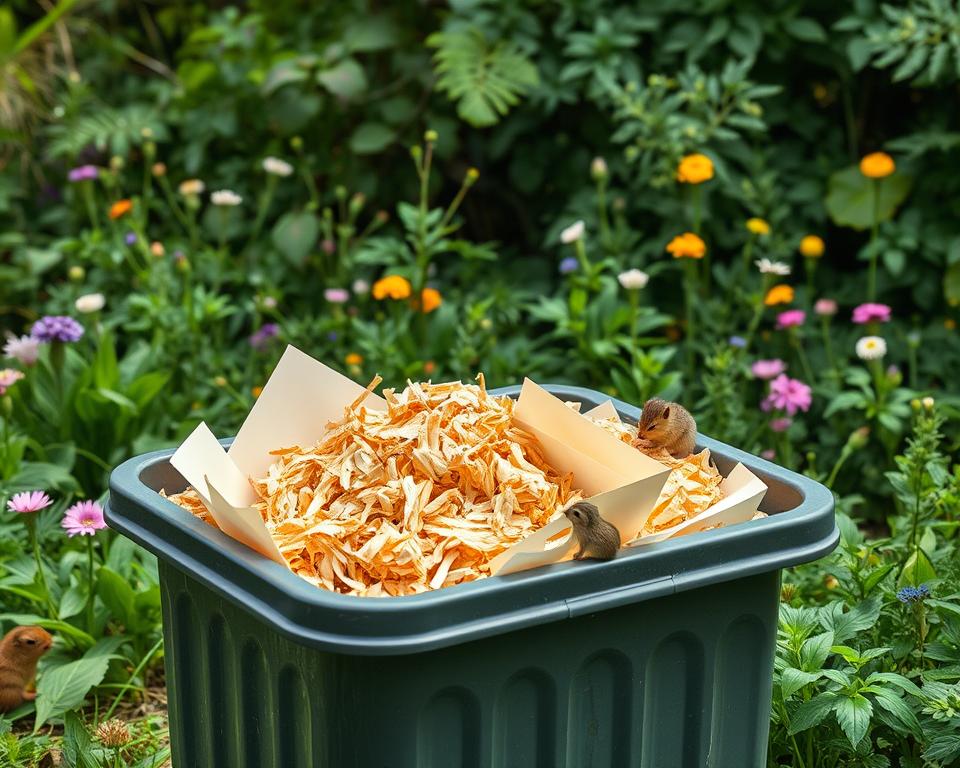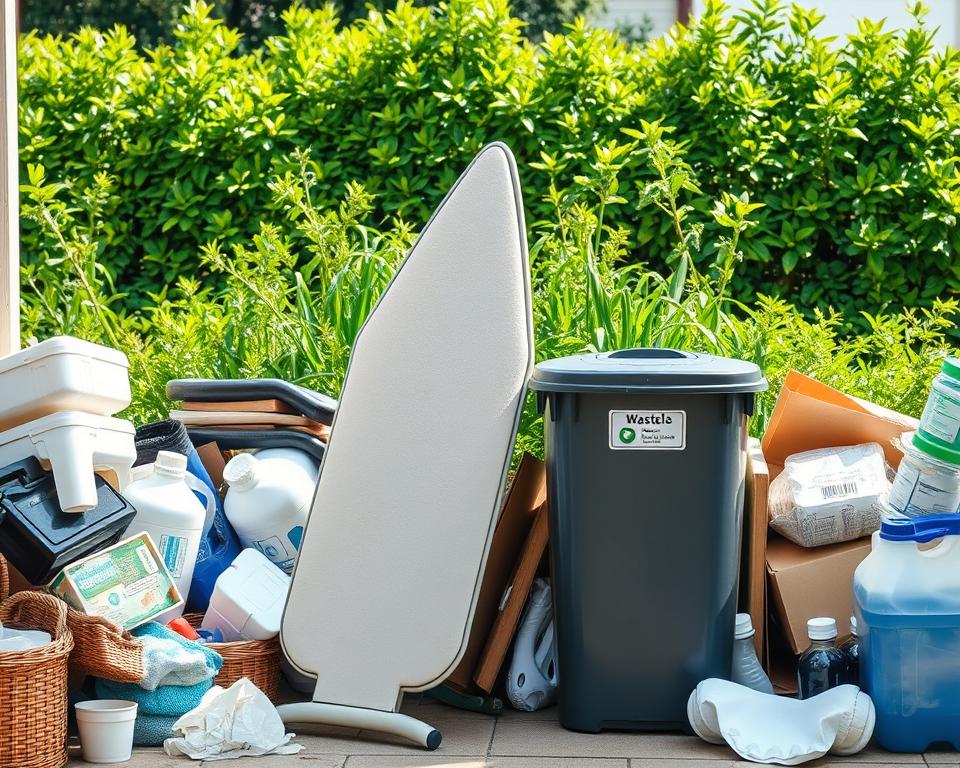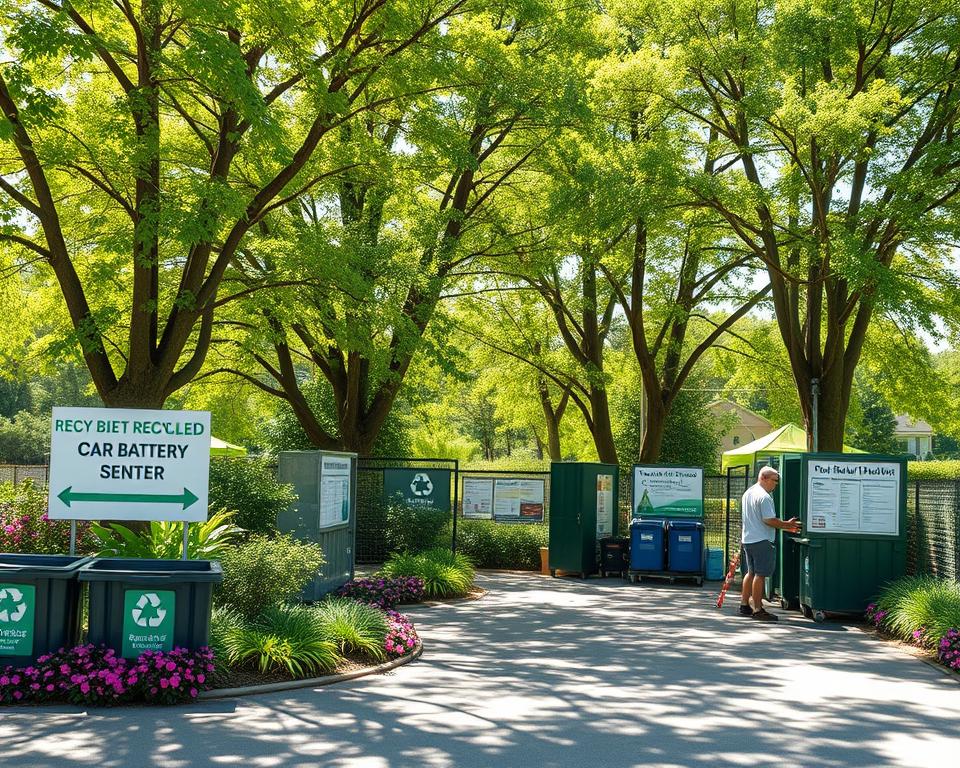Did you know that about 22 billion pairs of shoes end up in landfills every year? This huge number shows we really need to find better ways to throw away shoes. Shoes are bad for the environment because they take 30 to 40 years to break down. If you’re looking for ways to get rid of shoes that are good for the planet, you’re in the right place.
This article will show you how to dispose of shoes in an eco-friendly way. You can repair, donate, recycle, or even compost them. Each method helps lessen the harm shoes do to our planet. Let’s look at these green options together!
Key Takeaways
- 22 billion pairs of shoes contribute to landfill waste annually.
- Shoes can take decades to decompose, highlighting the need for better disposal practices.
- Repairing shoes at community clinics can significantly extend their lifespan.
- Recycling programs like Nike’s Reuse-A-Shoe assist in eco-friendly shoe disposal.
- Donating gently used shoes can provide support in developing countries.
- Upcycling offers creative ways to reuse old footwear and reduce waste.
Understanding the Environmental Impact of Shoe Waste
The shoe industry is growing fast, expected to hit USD 568.54 billion by 2031. Every year, over 20 billion shoes are made, causing huge waste. In the U.S., more than 300 million pairs are thrown away, with 95% ending up in landfills.
This waste is bad for the environment, including causing greenhouse gas emissions.
The Scale of the Issue
Shoes contribute about 1.4% of global greenhouse gas emissions. Each pair of sneakers creates around 30 pounds of CO2, like a 100-watt bulb for a week. Since shoes often need to be replaced every 8-12 months, the impact is huge.
Why Shoes Are Difficult to Decompose
The materials in shoes make them hard to break down. Synthetic shoes can take hundreds of years to decompose. Rubber shoes can last up to 80 years in landfills, and leather shoes need 25-40 years.
The design of shoes, with many materials, makes recycling hard. This leads to more waste.
| Type of Shoe | Decomposition Time | CO2 Emissions per Pair |
|---|---|---|
| Synthetic Shoes | Up to 1,000 years | 30 pounds |
| Leather Shoes | 25-40 years | 30 pounds |
| Rubber Shoes | 50-80 years | 30 pounds |
| Running Shoes | 300-500 miles before replacement | 13.6 kilograms |
Proper Shoe Disposal Techniques
Knowing when to throw away your shoes is key to proper disposal. Several signs show it’s time to say goodbye to your favorite shoes.
When to Dispose of Your Shoes
Checking your shoes often helps you dispose of them on time and responsibly. Here are some signs it’s time to get rid of your shoes:
- Visible Wear: If your shoes have holes, worn-out soles, or frayed parts, it’s time to consider disposal.
- Unpleasant Odors: Shoes that smell bad often need to be thrown away. This is a sign of proper shoe disposal.
- Compromised Fit: If your shoes don’t fit right or are uncomfortable, think about repair or disposal.
By checking your shoes, you can choose wisely. You might recycle or donate them instead of throwing them away. Places like Goodwill and Soles4Souls accept donations. Nike’s Move to Zero program also recycles shoes into new products. Knowing how to dispose of shoes responsibly helps the environment.
Good decisions about shoe disposal help the planet. It also reduces the huge problem of 300 million pairs of shoes in US landfills every year.
| Indicator | Action |
|---|---|
| Visible Wear | Consider recycling or donating |
| Unpleasant Odors | Opt for disposal or recycling |
| Compromised Fit | Explore repair options or proper disposal |
Repairing Your Shoes: A Sustainable Choice
Repairing shoes is a great way to be sustainable. It makes your shoes last longer and cuts down on waste. With DIY fixes, you can solve problems like sole separation easily. This saves resources and reduces the need for buying new shoes often.
Simple DIY Fixes for Common Shoe Problems
You can do simple repairs with a basic toolkit. You’ll need:
- Adhesive like Shoe-Goo
- Scissors
- Cleaning supplies
- Conditioners or polish
Learning to fix shoes yourself is both practical and good for the planet. Shoes made from natural materials like rubber and leather last longer. This means you won’t need to buy new shoes as often, saving money too.
When to Seek Professional Help
While DIY fixes work for many issues, some need a pro’s touch. For complex repairs, local cobblers like Bob’s Shoe Repair or Ralph’s Shoe Service are the best choice. They have the skills and tools to keep your shoes in top shape. Getting your shoes fixed by experts helps them last longer, showing your commitment to the environment.
Donating Your Old Shoes
Donating old shoes is good for the environment and helps those in need. Many people have shoes that don’t fit anymore. By donating, you give them a new life and reduce waste.
Finding the Right Donation Centers
It’s important to find the right places to donate shoes. Goodwill and Soles4Souls accept gently used shoes. Look for local organizations and shoe banks too. Some brands have special programs for collecting worn-out shoes.
Always check with these centers for their rules and what they need.
Preparing Your Shoes for Donation
To donate shoes, clean them and make sure they’re still wearable. Check for damage or wear. Cleaning is easy: just wipe the outside and make sure the insoles are clean.
This way, your shoes have a better chance of being accepted and finding new owners.
| Donation Center | What They Accept | Special Programs |
|---|---|---|
| Goodwill | Gently used shoes in good condition | Community support initiatives |
| Soles4Souls | All types of shoes | Distributing to those in need globally |
| Nike | Old athletic sneakers | Nike Grind program for recycling materials |
Shoe Swapping: Refresh Your Footwear Collection
Shoe swapping is a fun and green way to update your shoes without spending money. It lets people swap gently used shoes, making it a great way to share styles and cut down on waste. At shoe swap events, friends can share their shoes and find new ones in a fun setting.
More and more people see the value in sustainable shoes. Every year, over 90 million tons of textile waste are thrown away. Shoe swapping helps keep shoes in use and reduces the harm to the environment.
There are many local groups and online sites for shoe swapping. Look for them on community boards, social media, or at local events. This way, you can refresh your shoes and support sustainable fashion.
- Explore local shoe swap events in your community.
- Join social media groups focused on sustainable fashion.
- Invite friends to organize a shoe swap party at home.
Shoe swapping is a creative way to update your shoes and help the planet. You can find new styles to love without adding to waste.
Upcycling and Downcycling Old Shoes
Turning old shoes into something new is key to a greener future. Upcycling and downcycling cut down on waste and spark creativity. They help us make old shoes useful or beautiful again, helping our planet.
Creative Upcycling Projects for Shoes
Upcycling old shoes is fun and useful. Here are some cool ideas:
- Planters: Turn old sneakers or heels into planters. Add soil and plants for a fresh look in your home.
- Doorstops: Use heavy shoes like boots to keep doors open. It’s a fun and useful trick.
- Birdhouses: Make birdhouses from shoes like rain boots. They add charm to your garden and help birds.
Downcycling: Using Shoe Materials for Arts and Crafts
Downcycling shoes means using them for new projects. Here are some ideas:
- Shoe Laces: Use colorful laces for drawstring bags or bookmarks. They add a fun touch to everyday items.
- Shoe Soles: Use soles for DIY coasters or as bases for crafts. It’s a great way to reuse materials.
- Decorative Elements: Use shoe cuttings in mixed media art. It’s a fun way to be creative and reduce waste.
Upcycling and downcycling old shoes are creative and eco-friendly. They help us use old shoes in new ways. This approach makes us more resourceful and helps our planet.
Recycling Shoes the Eco-Friendly Way
Recycling shoes is key to reducing waste from footwear. The U.S. throws away over 300 million pairs of shoes yearly. Eco-friendly recycling is vital for a sustainable future. By using local recycling centers and shoe programs, we can help.
Finding Local Recycling Centers
Local recycling centers help dispose of old shoes right. Many places have programs for shoe recycling. This keeps waste down and helps the environment.
Soles4Souls and American Textile Recycling Service are great examples. They collect shoes to make new materials. This way, old shoes become something new.
Specialized Shoe Recycling Programs
Some brands lead in shoe recycling. Nike’s Reuse-A-Shoe turns old sneakers into new surfaces and shoes. Got Sneakers uses fundraisers to recycle shoes.
Rothy’s makes shoes from ocean waste, making them sustainable and recyclable. These efforts show how recycling shoes can make a difference.
| Recycling Program | Manufacturer/Organization | Purpose |
|---|---|---|
| Nike Grind Program | Nike | Transforms old sneakers into sports surfaces and new shoes. |
| Soles4Souls | Soles4Souls | Provides shoes to individuals in need while keeping textiles out of landfills. |
| Got Sneakers | Got Sneakers | Supports shoe drive fundraisers to collect and recycle old shoes. |
| Rothy’s Sustainability Program | Rothy’s | Utilizes ocean-bound waste in shoe construction and promotes recycling. |
Recycling shoes helps the environment and supports new products. By recycling, we help create a greener future. It reduces the need for new, non-recyclable shoes.
Composting Eco-Friendly Shoes
Shoe waste is a big problem, with millions of old shoes going to landfills each year. Composting shoes is a green solution, especially for compostable footwear made from natural stuff. Shoes need to be free from synthetic stuff and harmful glues to compost safely.
Brands like Baabuk, Nootkas, and AURA QUE are leading the way with compostable footwear. Their shoes use materials like cotton, hemp, and bamboo, which can break down. By picking these shoes, we help the planet and cut down on waste.
More people are choosing composting shoes, showing they care about the planet. As more brands go green, we’ll have more options. Making smart choices about shoes helps us and the planet, pushing for a better future.
Alternatives to Traditional Shoe Disposal
Every year, the U.S. throws away over 300 million pairs of shoes. Finding better ways to get rid of them is key. Sneaker drives are a great way to help. They collect used shoes for people who really need them.
Participating in Sneaker Drives
Sneaker drives are a great way to make a difference. Organizations like Got Sneakers hold these events. They turn old shoes into something useful for others.
By recycling shoes, we save materials and help the planet. Companies like Brooks Running use recycled materials in their shoes. This way, we can enjoy new shoes that are better for the environment.
Joining sneaker drives shows we care about the planet. It helps reduce pollution from shoe waste. By choosing these options, we help both the environment and our communities.
Investing in Quality Footwear for Longevity
Choosing quality footwear is key to reducing environmental impact and keeping you comfortable and stylish. Long-lasting shoes mean fewer trips to the store and less waste. They save you money and help the planet.
Quality shoes are often made to last. For example, a pair of men’s dress shoes can be resoled up to ten times. This makes them a smart, eco-friendly choice. Resoling costs between $48 to $65, which is cheaper than buying new shoes.
Women’s shoes can also be resoled several times, showing that durability is for everyone. This makes them a great investment for the planet and your wallet.
Choosing sustainable brands means picking shoes made with less harm to the environment. The shoe repair industry keeps 62 million pairs of shoes out of landfills yearly. Choosing materials that are good for the planet helps reduce waste.
Brands that use recycled materials or make their shoes in energy-efficient ways are better for the planet. They produce less pollution and waste.
Long-lasting designs also look good for years. When you shop, look for brands with certifications like GOTS or B Corp status. These show they care about the environment and people.
In short, buying quality footwear is good for the future. It reduces waste and lets you repair your shoes. It’s a smart choice for your wallet and the planet. Enjoy your sustainable shoe collection and know you’re helping the environment.
Disposing of Shoes: A Last Resort
When it comes to getting rid of shoes, we should think carefully. It’s best to try repair, donation, or recycling first. Textile waste is a big problem, with 85% of it ending up in landfills in the U.S. each year.
Instead of throwing shoes away, we should look for better ways to dispose of them. Companies like Nike have programs to reuse materials from old shoes. Many thrift stores and eco-friendly brands also encourage recycling shoes.
Throwing shoes away can harm the environment. It leads to more carbon emissions and uses up resources. We should learn about better ways to dispose of shoes.
By choosing to recycle or upcycle, we help the planet. Every step we take to avoid throwing shoes away makes a difference. If we must dispose of them, look for local recycling programs. This way, our shoes are handled with care and not just thrown away.
Conclusion
As we finish our look at eco-friendly shoe disposal, it’s clear our choices matter a lot. With over 20 billion pairs made every year, we must dispose of shoes responsibly. Options like donating, upcycling, and recycling, like Nike’s Reuse-a-shoe, help a lot.
It’s great to see groups like Soles4Souls donate millions of shoes. This shows how we can help others with what we no longer need. By choosing to repair or donate our shoes, we help the environment a little bit at a time.
By being mindful of how we get rid of our shoes, we can protect our planet. Let’s aim for a future where we waste less and help the environment more. Together, we can make a big difference in how we handle our footwear.
FAQ
What should I do with shoes that are worn out?
Before throwing away your shoes, think about fixing them, donating if they’re still good, or recycling. Only get rid of them if you really have to.
How can I recycle my old shoes?
Many places, like Nike’s Reuse-a-Shoe, can recycle your old shoes. They turn them into new stuff. Check out recycling programs in your area.
Are all shoes recyclable?
Not every shoe can be recycled because of the materials used. But, shoes made of rubber, plastic, and synthetic fibers can be recycled at special places. Make sure they’re clean and sorted right.
What are eco-friendly options for shoe disposal?
Good ways to get rid of shoes include fixing them, donating, recycling, or upcycling. These actions help the planet and are good for the future.
Where can I donate my old shoes?
You can give your old shoes to places like Goodwill or Soles4Souls. Make sure they’re clean and in good shape before you donate.
Can I compost my shoes?
Only shoes made from natural stuff without synthetic parts can be composted. Look for brands that make compostable shoes to help the environment.
What issues should I look for to know if my shoes need to be disposed of?
Signs your shoes might need to go include wear and tear, bad smells, or a bad fit. Checking your shoes can help you decide if you should fix or recycle them.
What resources are available for shoe swapping?
There are shoe swap events in many places or online groups. You can swap shoes, which is good for the planet and saves money.
How can upcycling my old shoes benefit the environment?
Upcycling turns old shoes into new things like planters or crafts. It cuts down on waste and encourages being creative with what you have.
Why is it important to buy quality footwear?
Buying good shoes means they last longer and can often be fixed. This reduces the need to throw them away often and helps the planet.
